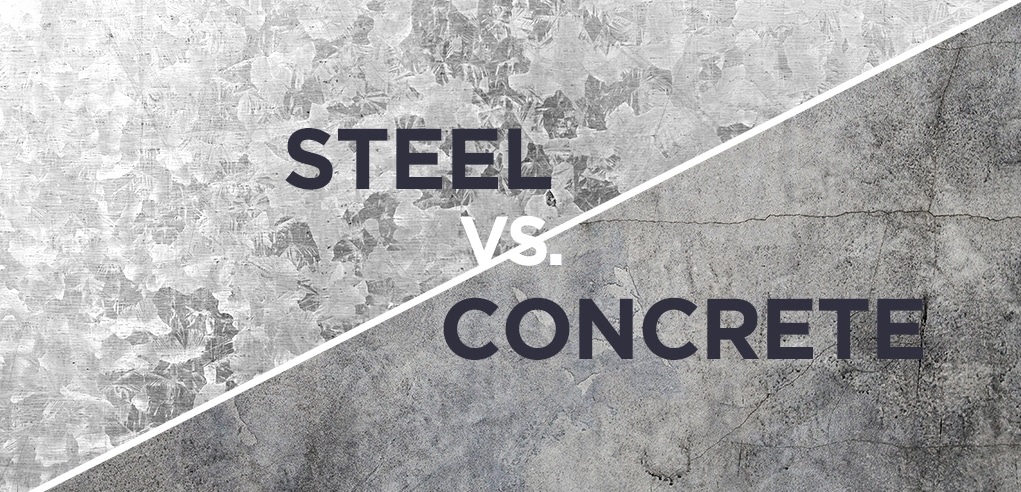Which building material is suitable for your project – Concrete or steel?
Construction projects require many decisions. A key decision is to find the most effective option and determine which process could produce ideal results.
If you are contemplating whether to use concrete or steel as your project’s primary building material, you have several factors to consider. Both are equally worthy structural materials. Concrete costs more, but arguably offers better overall performance. To understand which material suits your project better, you must know how they compare in the following ways –
1. Safety
Concrete:
Concrete requires no additional fireproofing treatments to meet stringent fire codes and performs well during both natural and manmade disasters. Because of concrete’s inherent heaviness, mass, and strength, buildings constructed with cast-in-place reinforced concrete can resist winds of more than 200 miles per hour and perform well even under the impact of flying debris.
With proper design, engineering, and construction, the seemingly rigid structures built with concrete can exhibit increased ductility – a must in areas prone to seismic activity.
Steel:
Experts acknowledge that steel with the addition of passive fire protection, such as spray-on fireproofing, buildings built of structural steel can sustain greater temperatures and, therefore, provide additional safety. Steel’s strength and ductility, combined with solid engineering and design, make it a safe choice in seismic zones.
2. Costs
Concrete:
A large cost-benefit to concrete is the fact that its price remains relatively consistent. On the other hand, concrete also requires ongoing maintenance and repairs, meaning added costs throughout its lifetime. Supply and demand may also impact the availability of concrete. Even though it can be poured and worked directly onsite, the process to completion can be lengthy and could accrue higher labor costs.
Steel:
A large majority of all steel manufactured today comes from recycled materials. This recycling usage makes the material much cheaper when compared to other materials. Although the price of steel can fluctuate, it typically remains a less expensive option compared to reinforced concrete.
3. Material Availability
Concrete:
With imported cement supplementing domestic supplies, skyrocketing shipping rates and limited freight transport have resulted in higher costs and unreliable supply.
Despite tight supplies of cement in some regions, the impacts have been greatest on smaller companies, builders, or contractors. Developers are using concrete frame buildings in every building sector and count on concrete for stable pricing and availability regionally. Cement companies are rapidly expanding and domestic capacity was expected to increase by 2008.
Steel:
Steel availability has been the subject of more than a few conversations lately, with the blame placed on the ever-expanding construction activity. However, experts from the steel industry are eager to dispel the myth that there simply isn’t enough steel to go around.
Over the past year, there’s been a lot of misperception out there in terms of the availability of material. There is no shortage. In 2004, usage was about 4 million tons of wide-flange structural product, which means there is certainly adequate capacity to meet any growth in the foreseeable future. Structural steel is readily available.
4. Construction Scheduling
Concrete:
Buildings with concrete can almost always be built faster. When compared to structural steel, sometimes twice as fast. It is not uncommon for cast-in-place reinforced concrete buildings to rise one floor every other day. Developers can finish jobs faster, earn a profit, recoup capital, and move on to the next project.”
When those ready-mix trucks pop up on-site, they need to come in, dump and leave very quickly. The faster the building is completed, the sooner the owner can allow occupancy and begin collecting income from tenants.
Steel:
We believe structural steel framing systems are the way of the future. We believe that they result in an accelerated schedule. We also believe that quality is enhanced because of off-site fabrication and that the productivity opportunities that exist in construction can be best addressed in off-site fabrication with a reduction of actual on-site time and on-site construction.”
Advancements in building information modeling have integrated the design, detailing, and fabrication of steel, which have resulted in an accelerated process. Design programs and CAD packages can pass information through a CIS/2 neutral database as a 3-D model to detailing and shop floor fabrication programs. This is compressing the steel portion of the schedule of projects by 40 or 50 percent. This productivity increases position steel as a viable construction material both now and in the future.
5. Design Possibilities
Concrete:
Concrete buildings are taking shape – many different shapes – everywhere. In addition to the unique aesthetics achieved with concrete construction, these buildings offer some very real space advantages.
With proper engineering, the concrete building can also offer beautiful designs.
Steel:
Steel has the highest strength-to-weight ratio of any construction material and with new construction methods, steel buildings remain a popular choice for office and multifamily developers. Use of girder slab, staggered truss, and castellated beam construction enables lower floor-to-floor heights than typically expected in structural steel buildings.
Looking for long spans of column-free space? Steel delivers. Steel can accomplish extremely long spans in structures with very open-bay footprints without intermediate columns. It’s a very flexible material in terms of different ways to address design requirements.
6. Environmental Considerations
Concrete:
Concrete is a material that is often locally sourced and thus typically requires minimal energy to transport to building sites. Rebar for concrete is often produced from recycled steel. At end of life, concrete can be crushed and recycled but the recycled material cannot be used for new building concrete.
Steel:
According to the British publication Building, 85% of steel is recycled, a process made easier by the fact that magnets are used in the process to sort steel. New steel made from scrapped steel uses about one-third of the energy necessary for steel from virgin materials. Steel fabrication made be done at a significant distance from a building site, increasing the energy needed for transport.
If you haven’t decided which side you’re on, don’t worry. Your education on steel and concrete buildings has only just begun.
——
To conclude, both technologies are used by an equal majority of builders today making both unique and useful in their own ways. Which is better, you ask? This solely depends on the kind of project one is looking to put up. The aforementioned pointers will help you decide which material better suits your needs.
If you are still curious about structural steel and are willing to read more about the technology, visit www.stratus-steel.com. We have drafted a simple technology overview that will cater to your questions.

